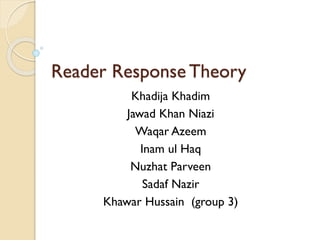Reader response theory
•Transferir como PPTX, PDF•
49 gostaram•89,258 visualizações
Denunciar
Compartilhar
Denunciar
Compartilhar

Recomendados
Mais conteúdo relacionado
Mais procurados
Mais procurados (20)
What is Style and Stylistics? Traditional, Modern and Linguistic Concept of S...

What is Style and Stylistics? Traditional, Modern and Linguistic Concept of S...
Unit 1 introduction to Literary Theory & Criticism

Unit 1 introduction to Literary Theory & Criticism
Destaque
Destaque (6)
Semelhante a Reader response theory
Semelhante a Reader response theory (20)
We Need a Hero: Facilitating Academic Conversations with Diverse Learners

We Need a Hero: Facilitating Academic Conversations with Diverse Learners
Último
Último (20)
Measures of Central Tendency: Mean, Median and Mode

Measures of Central Tendency: Mean, Median and Mode
This PowerPoint helps students to consider the concept of infinity.

This PowerPoint helps students to consider the concept of infinity.
Presentation by Andreas Schleicher Tackling the School Absenteeism Crisis 30 ...

Presentation by Andreas Schleicher Tackling the School Absenteeism Crisis 30 ...
Seal of Good Local Governance (SGLG) 2024Final.pptx

Seal of Good Local Governance (SGLG) 2024Final.pptx
ICT role in 21st century education and it's challenges.

ICT role in 21st century education and it's challenges.
Web & Social Media Analytics Previous Year Question Paper.pdf

Web & Social Media Analytics Previous Year Question Paper.pdf
Python Notes for mca i year students osmania university.docx

Python Notes for mca i year students osmania university.docx
Z Score,T Score, Percential Rank and Box Plot Graph

Z Score,T Score, Percential Rank and Box Plot Graph
Asian American Pacific Islander Month DDSD 2024.pptx

Asian American Pacific Islander Month DDSD 2024.pptx
Beyond the EU: DORA and NIS 2 Directive's Global Impact

Beyond the EU: DORA and NIS 2 Directive's Global Impact
Reader response theory
- 1. Reader Response Theory Khadija Khadim Jawad Khan Niazi Waqar Azeem Inam ul Haq Nuzhat Parveen Sadaf Nazir Khawar Hussain (group 3)
- 2. Introduction Emerged in 1930 Primary focus on reading It is text based not author based “text and text alone” Also called as “Affective fallacy”
- 3. Leading Proponents Stanley Fish Wayne Booth Louise Rosenblatt
- 4. Theoretical Assumption Literature is a per formative art and each reading is a performance. The literary text possess no fixed and final meaning literary meaning is created by the interaction of the text and reader Reader is not passive but active Role of reader cannot be ignored
- 5. Salient features Acknowledged importance of text and reader Text relationship with reader Reader is 3rd party Reality exist in readers mind Work is fully created when readers assimilate it Text has not one inherent meaning but it depend on individual interpretation.
- 6. Types of responses Initial emotional response Interpretive Analysis Question Summary Arguing with author Inter textuality
- 7. Text Identity Imaginative literature is lived by reader 2 time reading of single text produces great insight in the reader mind Text alone is nothing as a unit but it completes is identity after the reader interpretation
- 8. Types of Reading Aesthetic Afferent Aesthetic reading for pleasure emotional focus literature. Efferent reading for information telephone book history text. In reader response theory reading must be aesthetic rather than afferent.
- 9. Kinds of Meaning in a Text Determinate Indeterminate Determinate basically the facts in the text Indeterminate are the “gaps” in the text which is filled by readers In RR theory, indeterminate meaning are more focus
- 10. Kinds of Reader Implied Reader Actual Reader Implied reader finds out the determinate meaning of the text Actual reader fills the gap in the text and find out the indeterminate meaning of the text
- 11. Techniques of Reading Reader extracts the meaning through Experiencing Hypothesizing Exploring Synthesizing
- 12. Benefits Broaden the horizon of mind Multiple interpretation Cultural study Encourage the students to make interpretations
- 13. Continued…. Dependence on the teachers is discouraged Students trust on their own Responses Students ability of responsibility and authority is increased Personal responses are valued Help reader to become better critical reader
- 14. limitations Not every interpretation may be valid. Students can also go beyond the interpretation levels. Students can also disagree and argue with each others interpretations.
- 15. Enhancement of RR Literature circles General writing Peer writing group Open ended discussion
- 16. Comparison Reader Response Method Traditional Method Enhance Ideas Student dependent Student become tolerant Produces multiple interpretation Better critical reader Single idea Teacher dependent Teacher biasness Discourages enhancements of ideas No practice of mind
- 17. Conclusion Reader response theory is the best theory which makes the reader and students to be active and to analysis a text by their own ways it achieved great importance in 19th century and for students and teacher it is the most reliable method of studying and teaching
